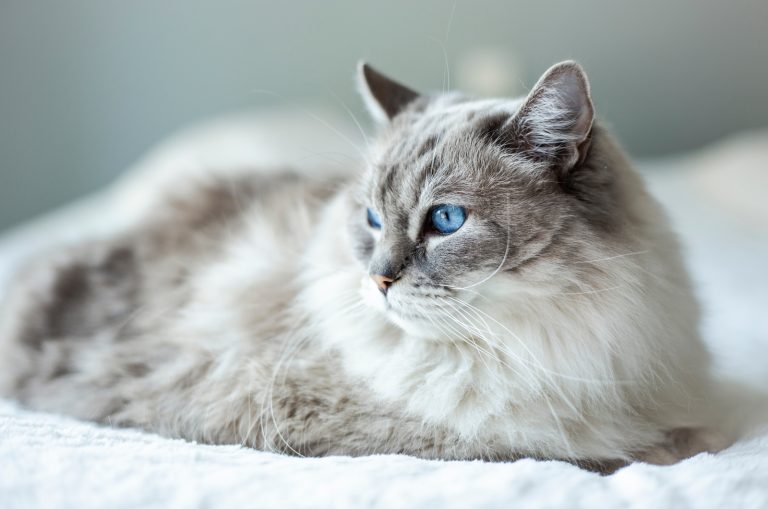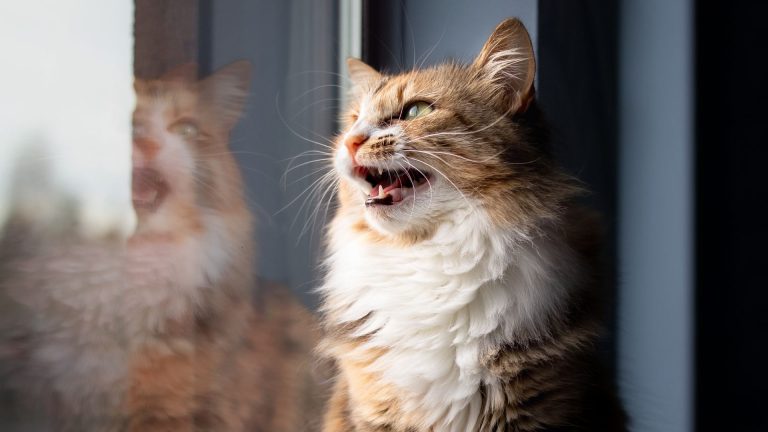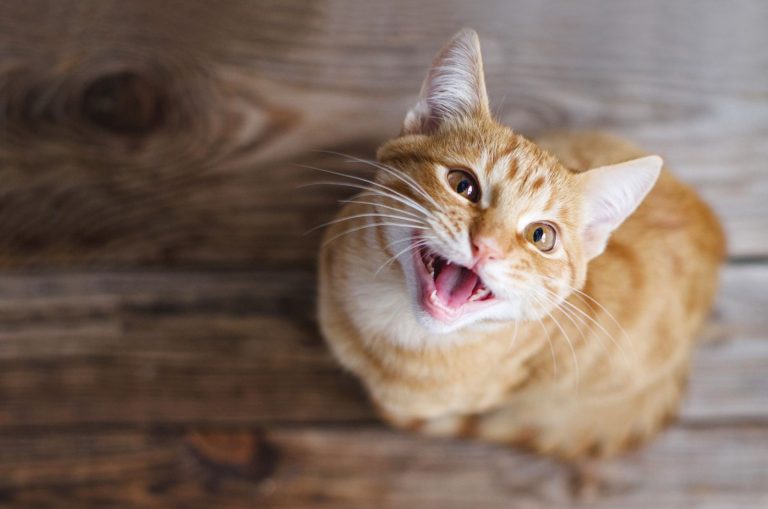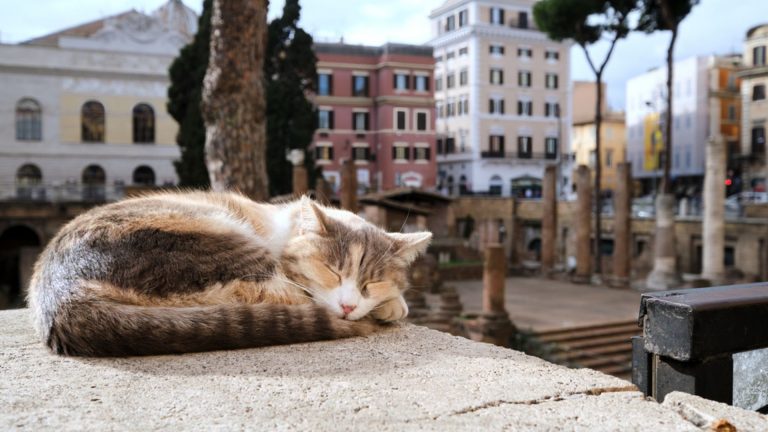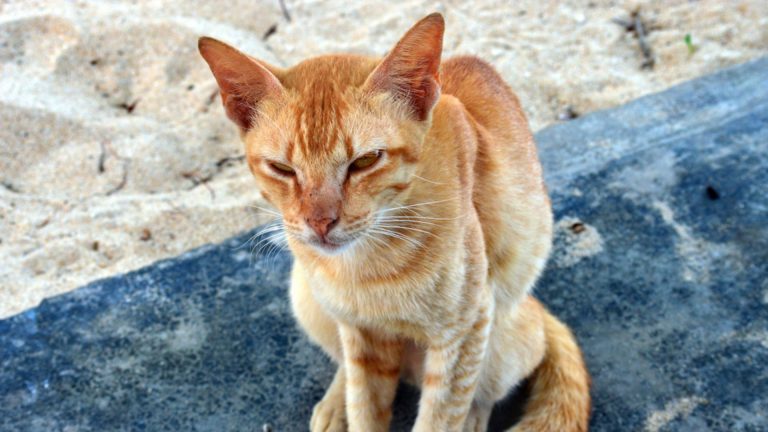When To Put A Cat With Hyperthyroidism To Sleep
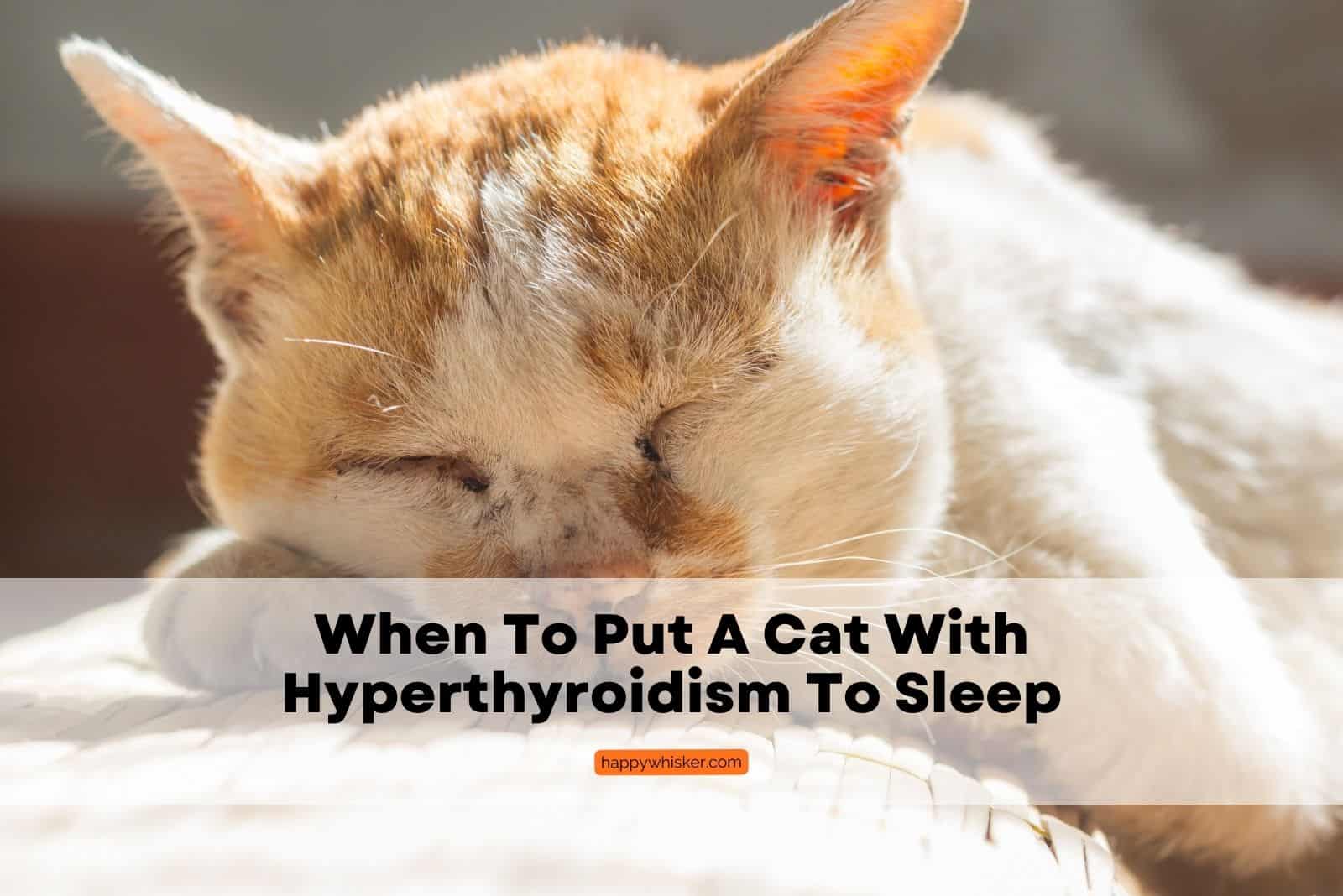
No pet owner wants to hear the words “Your cat has hyperthyroidism.” But unfortunately, this is a reality for many cat owners.
Hyperthyroidism is a disorder that can cause a number of health problems and typically requires lifelong medication.
While many cats may have long and healthy lives with proper care and treatment, there may come a time when the wisest option for your cat is to put them to sleep.
In this article, we’ll talk about when to put a cat with hyperthyroidism to sleep, and what the cat owner’s options are.
When To Put A Cat With Hyperthyroidism To Sleep: A Brief Intro
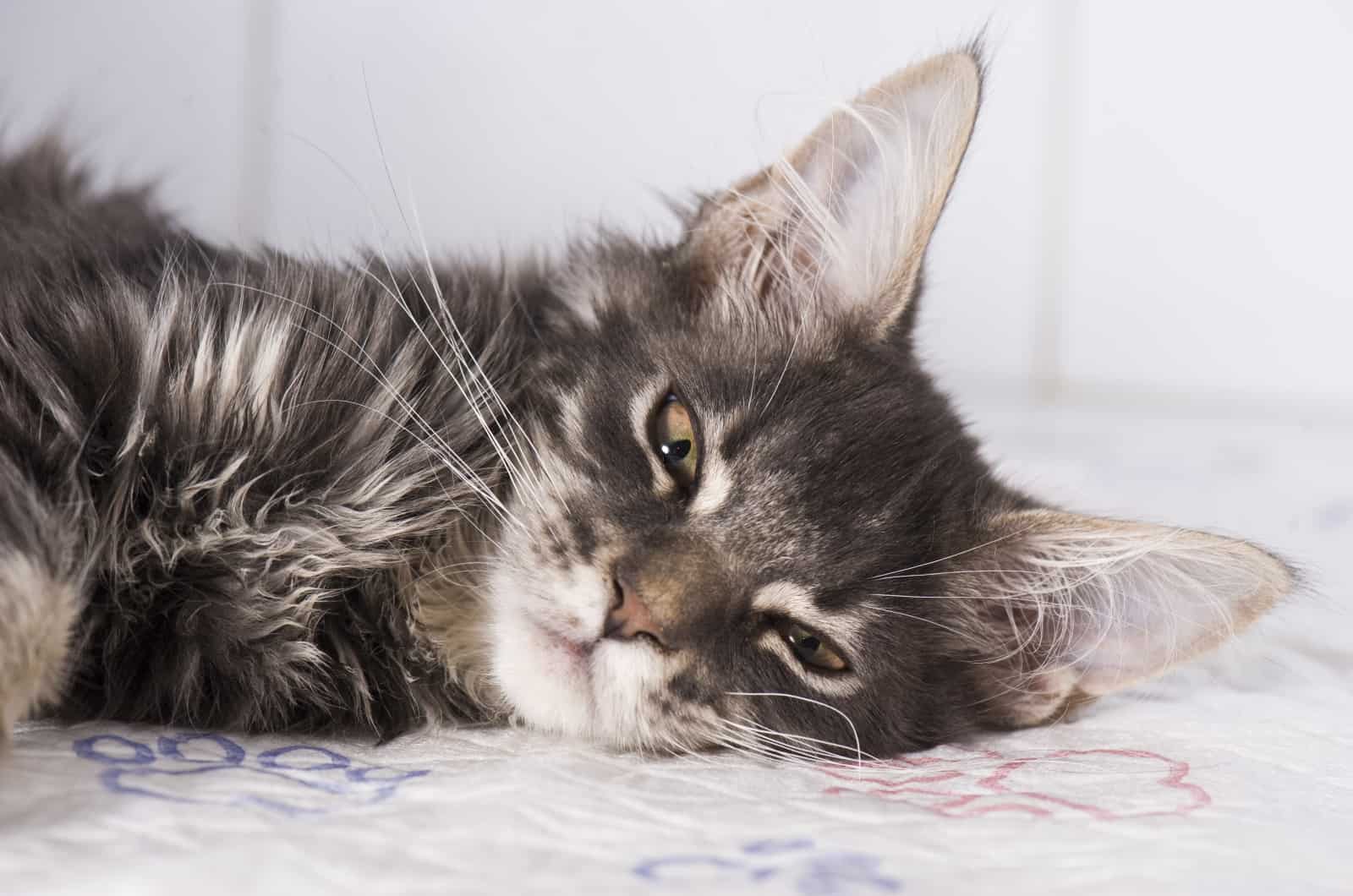
As a vet, I have to say the most difficult decision I have to make is whether to suggest a pet owner euthanize their beloved pet or not.
When it comes to cats suffering from hyperthyroidism, a lot of times, I have to suggest that owners put their kitties to sleep, as it’s the kindest thing to do. But that’s never an easy decision to make – either for me to suggest euthanization or the cat owner to proceed with the euthanization.
Last month, I had to put a cat with Hyperthyroidism to sleep that I’ve been treating for over two years. Her name was Bubbles, and she was a very playful cat that I had grown very fond of.
We had progress treating the cat’s hyperthyroidism, but suddenly, she stopped responding to treatment and her quality of life was drastically deteriorating.
After much deliberation and consultation with the owner, we agreed that the most humane thing to do was to put the cat to sleep.
It was an incredibly difficult decision to make, as the cat had been a part of the family for many years, but in the end, we all knew it was the right thing to do.
Overview Of Feline Hyperthyroidism

Feline hyperthyroidism is a common endocrine disorder that mostly affects senior cats. It is caused by an overproduction of thyroid hormones (T3 and T4) by the thyroid gland, located in the neck.
Hyperthyroidism in adult and older cats can be the result of an adenoma or adenocarcinoma of the thyroid gland.
Cornell University College of Veterinary Medicine notes that: “Cats afflicted with hyperthyroidism usually develop a variety of signs that may be subtle at first but that become more severe as the disease progresses.“
However, the characteristic clinical signs of hyperthyroidism are:
• loss of body mass despite normal or increased appetite
• polydipsia
• polyuria
• frequent defecation (the amount of feces is greater)
• vomiting
• diarrhea
• behavioral changes; cats are usually hyperactive with occasional signs of aggression.
The prognosis is better with an early diagnosis of hyperthyroidism, but there are presently no proven preventative therapies for the condition, says VCA Animal Hospital.
A study published in the Journal of Veterinary Internal Medicine about the risk factors for hyperthyroidism in cats found that two genetically related cat breeds, Siamese and Himalayan, were found to have a diminished risk of developing hyperthyroidism.
The study also shed a light on the importance of a cat’s diet in the disease development. In particular, the study showed that cats who ate commercially prepared canned food had an approximate 2-fold increase in risk of disease, compared to cats that did not eat canned food.
Our understanding of feline hyperthyroidism has progressed since the initial descriptions of the disease in the literature in 1979 and 1980, and it is now a disease that veterinarians (including myself) frequently address.
However, even though the disease is common, and there are treatment options available, there are always cases where cats do not win the battle with this disease, unfortunately.
Overview Of Feline Euthanasia
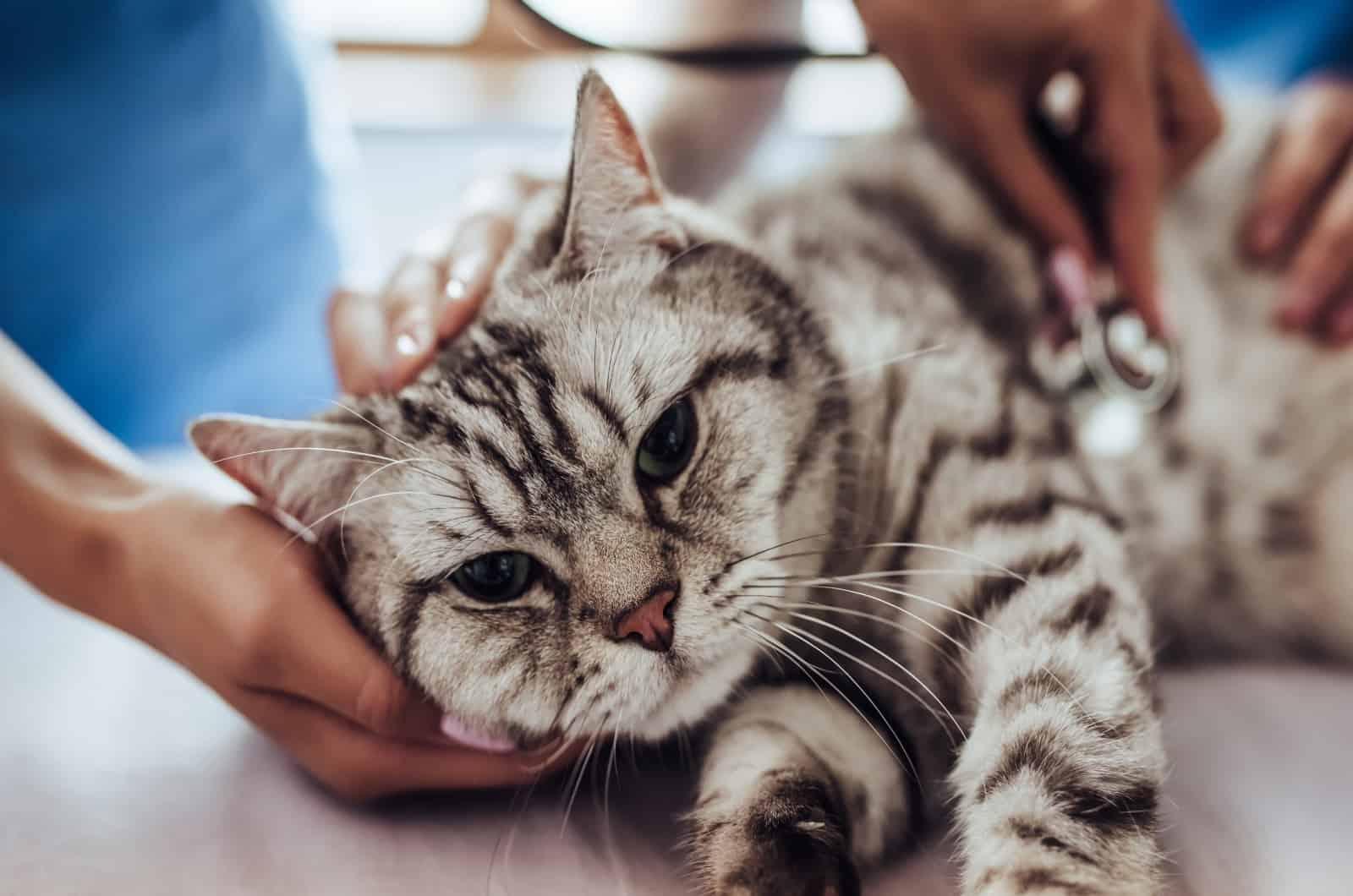
The decision to put a beloved cat to sleep due to fatal disease or because its quality of life has declined is not easy for pet owners to make.
Euthanasia for cats is the most compassionate approach to put an end to a cat’s suffering, as it aims to provide the animal with a peaceful death.
What does the euthanization procedure look like?
According to a 2019 study named Animal hospice and palliative care: Veterinarians’ experiences and preferred practices, “The preferred method of euthanasia is a two-step method of sedation and euthanasia.” I can confirm this to be true.
During the euthanasia process, the veterinarian will use a sedative to make the cat unconscious. This sedative is usually an anesthetic that is given intravenously.
Once the pet is unconscious, the vet will administer a euthanasia solution, which will cause the cat to stop breathing and their heart to stop beating.
The American Veterinary Medical Association states, “Death is quick and painless. Your pet may move his/her legs or head or breathe deeply several times after the drug is given, but these are reflexes and don’t mean that your pet is in pain or is suffering.”
For more information about the process of euthanization that veterinarians follow, I suggest you check out: AVMA Guidelines for the Euthanasia of Animals: 2020 Edition
A Vet’s Opinion: When Is It The Right Time To Put A Cat With Hyperthyroidism To Sleep?
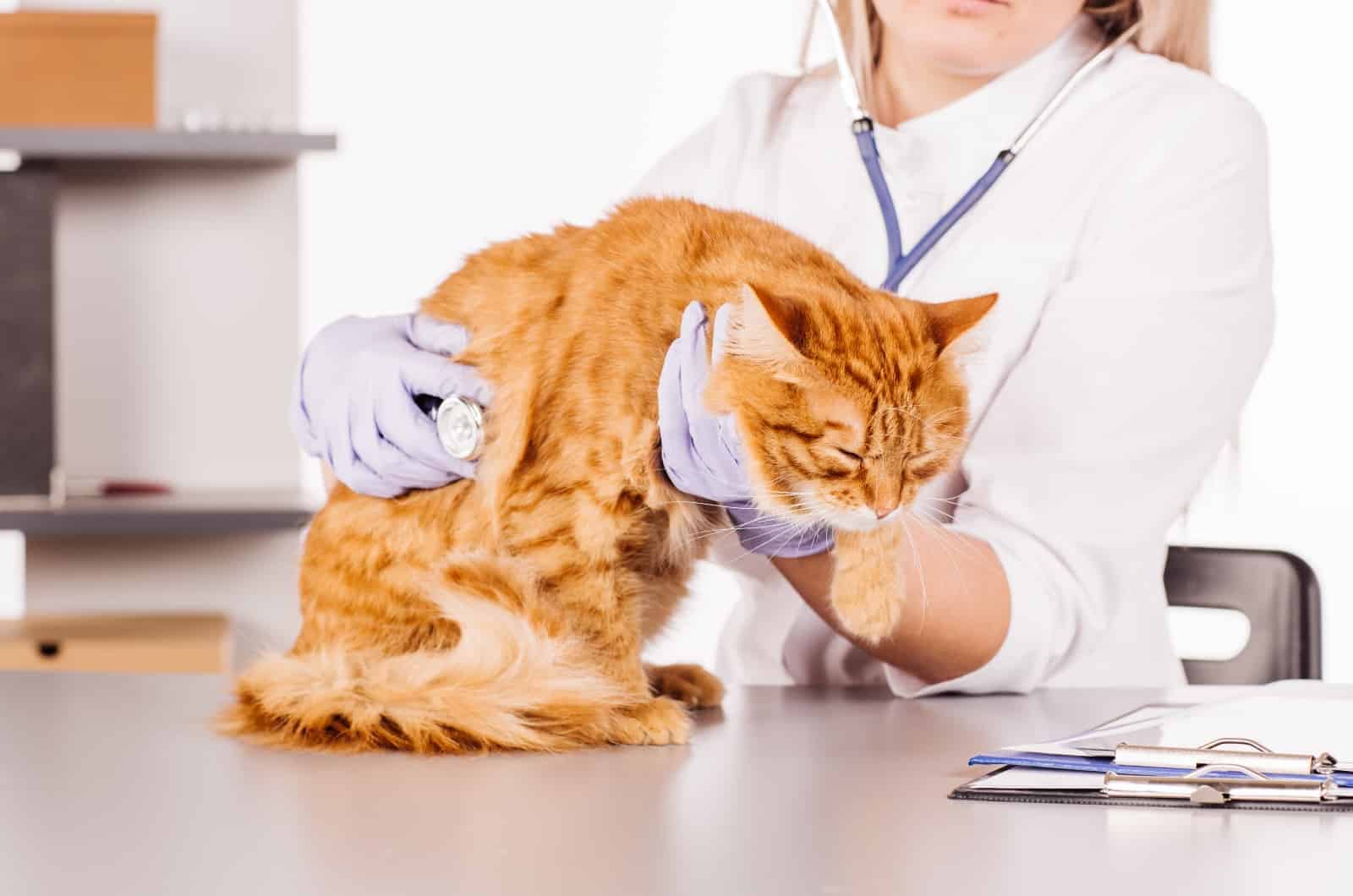
When the issue of potential euthanization arises, I always tell the cat owner to consider the following factors:
• Cat’s quality of life
• Availability of treatment
• Likelihood of successful treatment
• Prognosis
• The ability of the owner to carry on the treatment
• The vet’s opinion
All of these factors that influence the decision to put a cat to sleep will be discussed in the next part of the particle.
But for those who want a straightforward answer, here it is:
If the cat is suffering from a severe form of the condition that cannot be managed with medication or other treatments, it may be the right time to consider euthanasia.
In many cases, hyperthyroidism can be successfully managed with medications, diet, and perhaps surgery (if needed).
However, if the cat’s condition is severe and its quality of life is compromised, euthanasia may be the most humane option.
Now, let’s talk more about the things that should be considered before opting for euthanization.
1. Cat’s Quality Of Life
The decision to euthanize a cat is an extremely difficult one, and owners must consider the quality of life that the cat is currently experiencing before making a decision.
What I always do is suggest pet owners evaluate their pet’s quality of life using a Quality of life scale.
The HHHHHMM Quality of Life Scale (also known as the HHHHHMM Scale) is a self-report measure of quality of life of a pet.
The scale assesses an owner’s perception of the cat’s quality of life based on a number of carefully thought-out questions.
The Hs in the name stand for: Hurt, Hunger, Hydration, Hygiene, Happiness, Mobility, and “More good days than bad days.”
Here’s what the scale looks like:
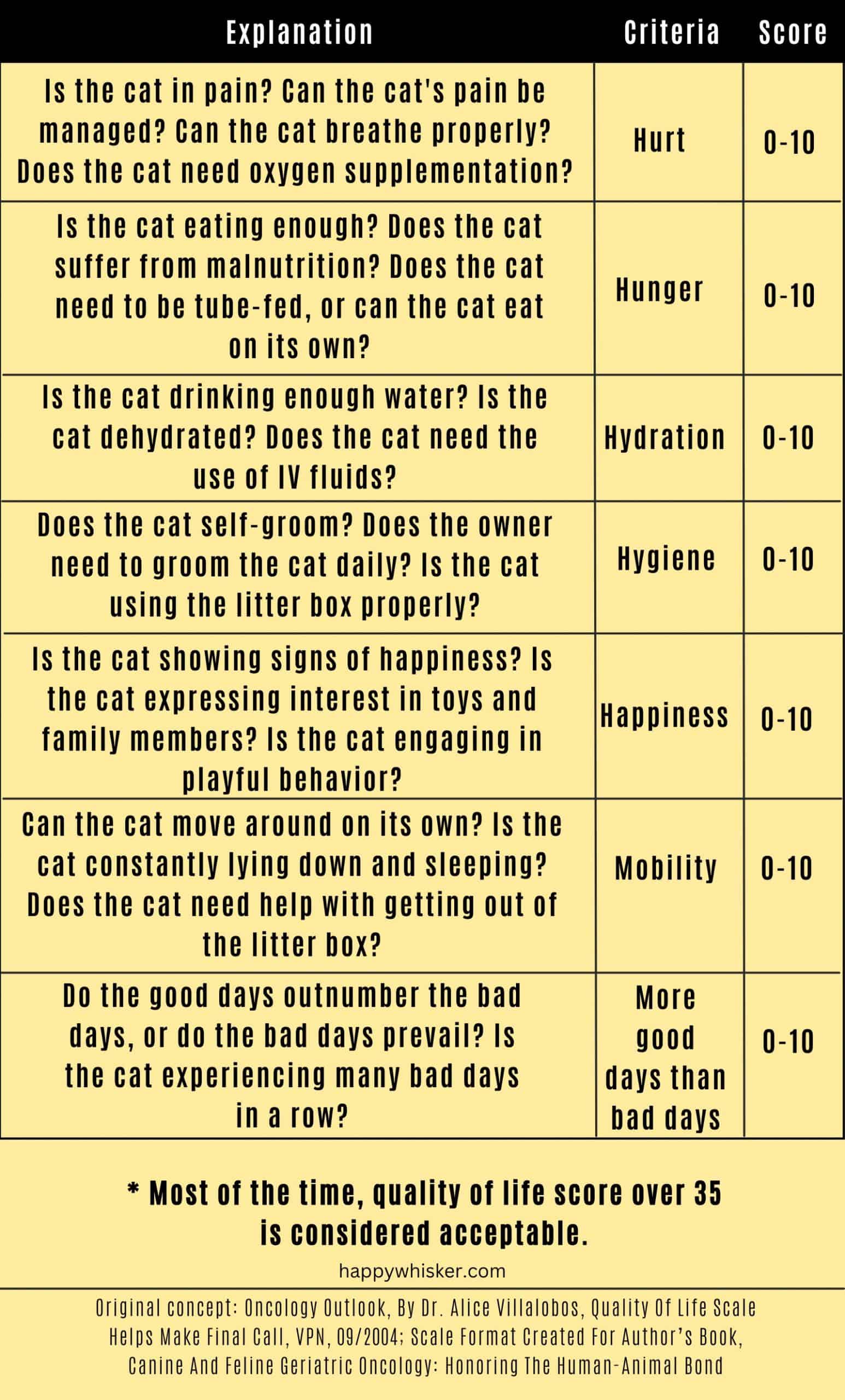
The cat’s owner should grade a number of different aspects of a cat’s life on a scale from 0-10. The total score ranges from 0-70, with higher scores indicating a better quality of life.
In general, a score near the lower end of the scale (0-35) would suggest a low quality of life.
Of course, a cat will not be put to sleep simply due to having a low quality of life, considering that there might be a possible treatment option. There are other factors to consider, so let’s talk about them now.
2. Availability Of Treatment
If there is any potential for treatment, then the cat owner may be more likely to explore those options before making the difficult decision to euthanize their pet.
Potential treatment options should be discussed with the cat’s veterinarian. They’re familiar with the cat’s symptoms of hyperthyroidism and medical history, and they’re most likely going to tell you about the availability of treatment.
However, if there is no potential for treatment, or the treatment options are too expensive or invasive, then the cat owner may decide that euthanizing the cat is the most humane option.
3. Likelihood Of Successful Treatment
The likelihood of successful treatment is a major factor when deciding whether to proceed with euthanasia for cats.
If the prognosis for successful treatment is good, then the owner may opt to pursue medical treatment, as this offers the cat the best opportunity to live a longer, healthier life.
On the other hand, if the likelihood of a successful treatment is poor and the cat is suffering, then the owner may opt to proceed with euthanasia as a more humane end-of-life experience.
Sometimes, treatment is available (perhaps the cat’s vet has not exhausted all possible treatment options), but the cat is too weak to endure the treatment. In this case, euthanization should be considered.
4. Prognosis For The Cat’s Health
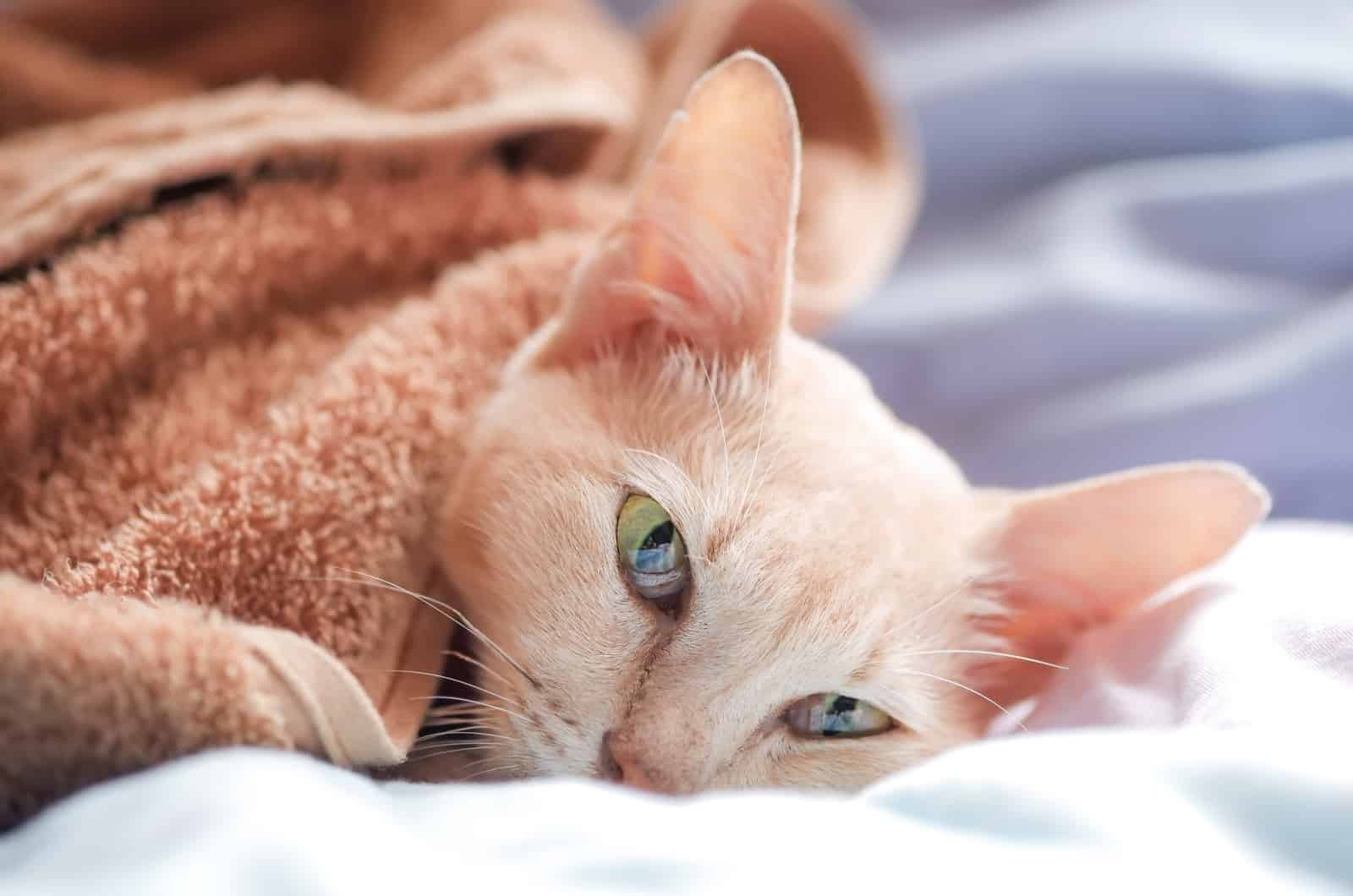
The prognosis for the cat’s condition has a significant impact on an owner’s choice to euthanize the cat.
If the prognosis is poor, then the owner may decide to euthanize the cat in order to end the cat’s suffering and to avoid further pain or distress.
This is especially true for cat owners whose cat’s health condition has severely deteriorated, and further treatment is not likely to bring significant improvement.
However, if the prognosis is good, then the owner may choose to pursue treatments in order to improve the cat’s quality of life!
In some cases, especially if the cat is not very old, even if its state of health is bad at the moment, proper treatment can help the cat get better and have a good life.
Therefore, the prognosis for a cat’s health in the future is a very important factor in deciding whether to euthanize a cat or not.
5. The Ability Of The Owner To Carry On The Treatment
The ability of the owner to carry on the treatment is something to be taken into consideration when thinking about proceeding with treatment or opting for euthanization.
If the owner is financially able to provide the necessary medical care and treatment, then they may choose to pursue all available options before euthanizing their pet.
However, if the cost of treatment is too great or the prognosis is poor, then the owner may decide that euthanasia is the kindest option for their beloved pet.
The financial cost of continued investigation or treatment of a cat’s health issues can get very high, up to several thousand dollars, which might be too much of a financial burden for some cat owners, which is something most of us can understand.
6. The Vet’s Opinion
The veterinarian’s opinion can have a significant influence on an owner’s decision to euthanize their cat.
Veterinarians are trained professionals who can provide advice and guidance on the best course of action for the pet. They give opinions based on their experience and knowledge of the cat’s health condition.
Of course, the decision to euthanize the cat rests with the owner, but the vet’s opinion can help the owner make an informed and compassionate decision for their beloved pet.
A 2022 study published in Veterinary Record talks about negotiations around euthanasia decision making for dogs and cats in the UK. The writers note something I found particularly interesting.
They state: “The veterinary surgeon and owner did not always agree on euthanasia as an option and instances of euthanasia refusal by both parties were recorded.”
They further add that: “In several consultations, an owner’s request for euthanasia was refused by the veterinary surgeon, often because the animal was considered treatable or to have a reasonable quality of life.”
I am mentioning this just to emphasize the importance of the veterinarian and the pet owner in the decision to euthanize the pet!
Management of Feline Hyperthyroidism – Possible Treatment Options
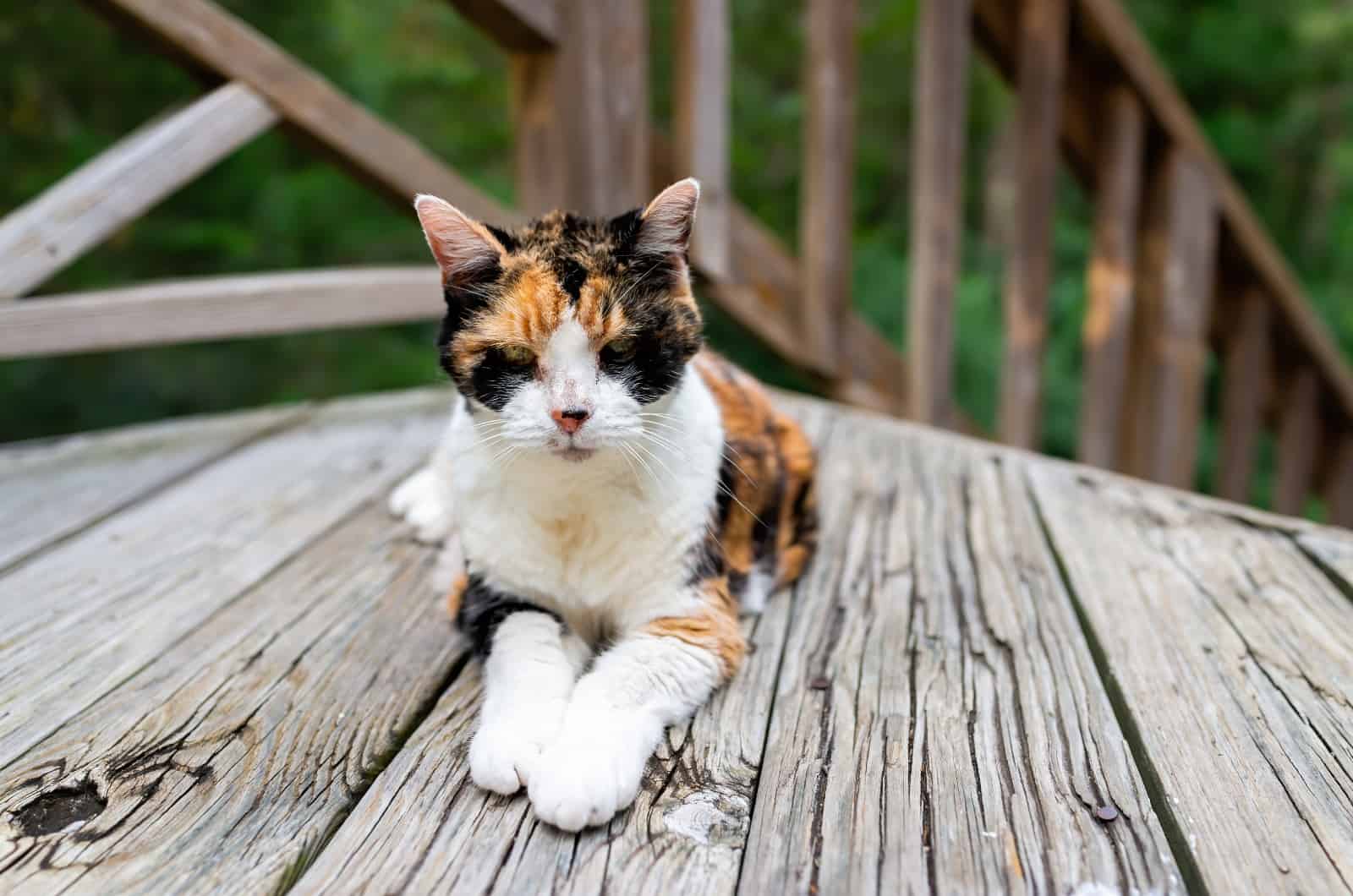
Now that we’ve gone over the 6 vital aspects to look into before deciding to euthanize a cat, let’s look more closely into treatment options available for cats suffering from hyperthyroidism, just in case there’s a possibility your cat’s disease can still be treated.
2016 AAFP Guidelines for the Management of Feline Hyperthyroidism published in the Journal of Feline Medicine and Surgery emphasize that: “The choice of therapy often depends on factors such as the cat’s age, comorbidities, treatment cost, availability of treatment options, and the clinician’s recommendation and expertise.”
Of course, this is something you will discuss with your veterinarian, but let me familiarize you with the potential treatment options:
1. Radioactive Iodine Treatment
This treatment involves injecting a small amount of radioactive iodine into the cat’s bloodstream. The radioactive iodine then damages or destroys the thyroid cells that produce the thyroid hormones.
For most veterinarians, this is the “go-to” treatment of hyperthyroidism in felines, as it has minimal side-effects, but is still very efficient.
Radioactive iodine therapy for feline hyperthyroidism: Efficacy and administration routes is a scientific study that evaluated the efficacy of radioactive iodine (131I) administration in treating hyperthyroidism in cats. 50 cats were treated with different doses of radioactive iodine.
The study found that all cats tolerated the treatment well and no side effects were reported. The study also found that 30 days after treatment, the cats had a significant decrease in the thyroid hormone levels in the blood, and 47 out of 50 (94%) cats were treated successfully.
The success rate with this therapy is very high, however, not every cat responds well to this treatment – there is always a chance the cat’s too weak or the disease has advanced to late stage hyperthyroidism.
2. Medical Therapy
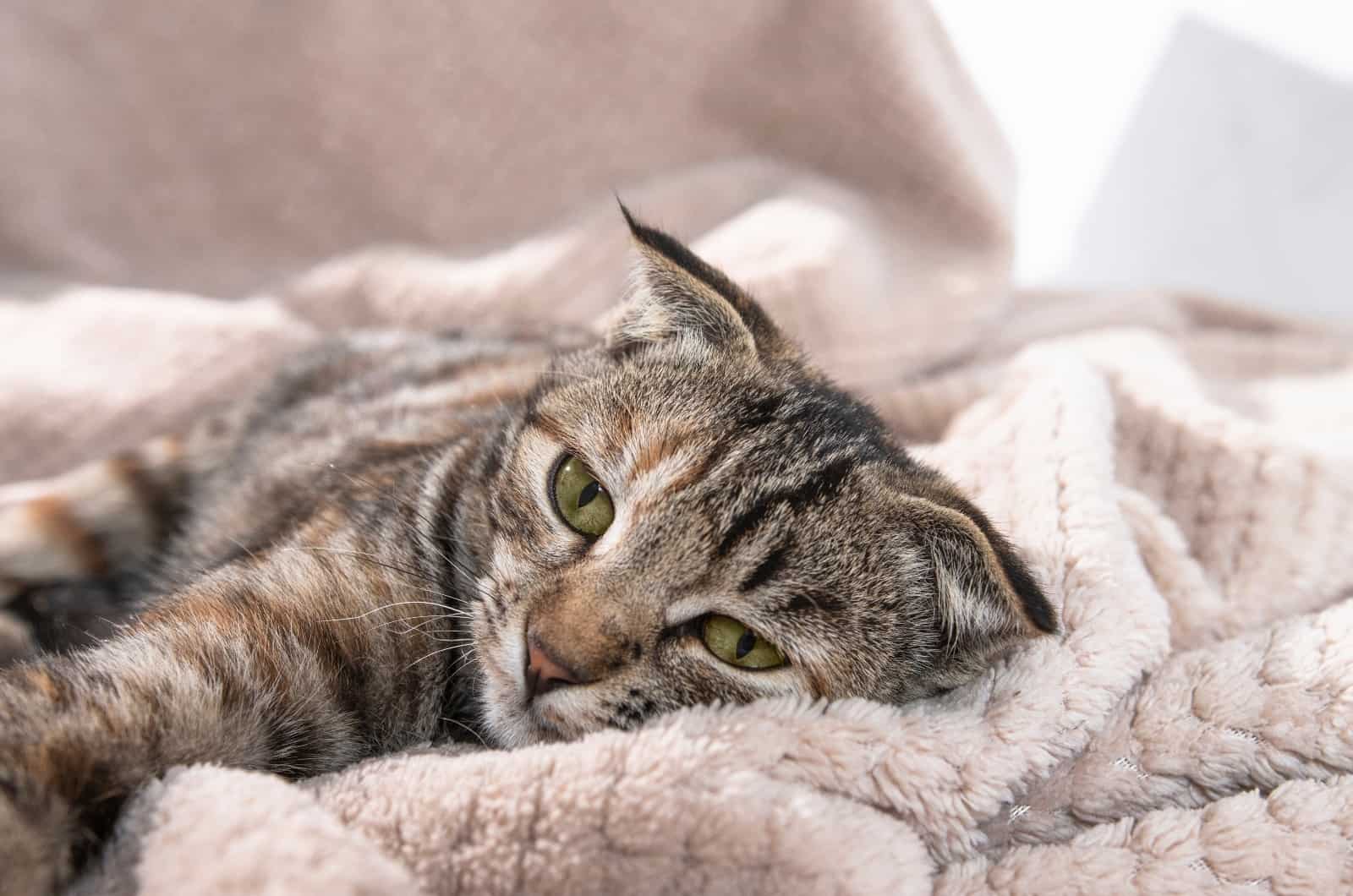
There are several different types of thyroid medication that can be used to manage hyperthyroidism in cats.
As MSD Veterinary Manual states, these medications include methimazole and carbimazole, which both inhibit the production of thyroid hormone. They are usually given orally and are generally well-tolerated.
Antithyroid drugs can be used long term as a sole treatment, short term to stabilize the cat before surgery, or if radioiodine therapy is not available for some reason.
3. Surgical Thyroidectomy
A surgical thyroidectomy is the removal of one or both of the cat’s thyroid glands.
A review article entitled Surgical options for the treatment of hyperthyroidism in the cat states, “Since more than 80% of hyperthyroid cats have neoplastic changes in both thyroid glands, bilateral thyroidectomy is necessary for treatment of the majority of hyperthyroid cats.”
Surgical removal of the affected thyroid glands is a more invasive treatment than all the above mentioned forms of treatment, but also considered to be a definitive treatment option.
A study published in Clinical Techniques in Small Animal Practice in 2006 talks about feline thyroidectomy. The writer of the study (who is a DVM) states, “The prognosis for hyperthyroid cats after thyroidectomy is good.”
He then adds, “Treated cats show improved behavior and significant weight gain.”
The success rate of this procedure depends on the size and location of the thyroid glands, as well as the cat’s overall health.
4. Dietary Therapy
Cats with thyroid disease may benefit from eating a low-iodine diet! How so?
Production of thyroid hormone requires uptake of sufficient amounts of dietary iodine by the thyroid gland. Therefore, limiting dietary iodine intake could be used to control thyroid hormone production associated with hyperthyroidism in cats.
A vet can give you a special cat food prescription diet that can help ease your cat’s medical condition symptoms.
A 2015 article named Effect of Feeding an Iodine-Restricted Diet in Cats with Spontaneous Hyperthyroidism investigated how diet influences cats with this disease.
This study is a retrospective case series of 49 cats with spontaneous hyperthyroidism, which is treated by exclusively feeding a commercially available iodine-restricted diet.
The study found that thyroid hormone in serum normalized in 42% of cats within 60 days and 83% of cats within 180 days.
It concluded that the iodine-restricted diet is effective at maintaining serum thyroid hormone within normal ranges in the majority of cats. However, not all clinical signs of hyperthyroidism improved in the treated cats.
FAQ
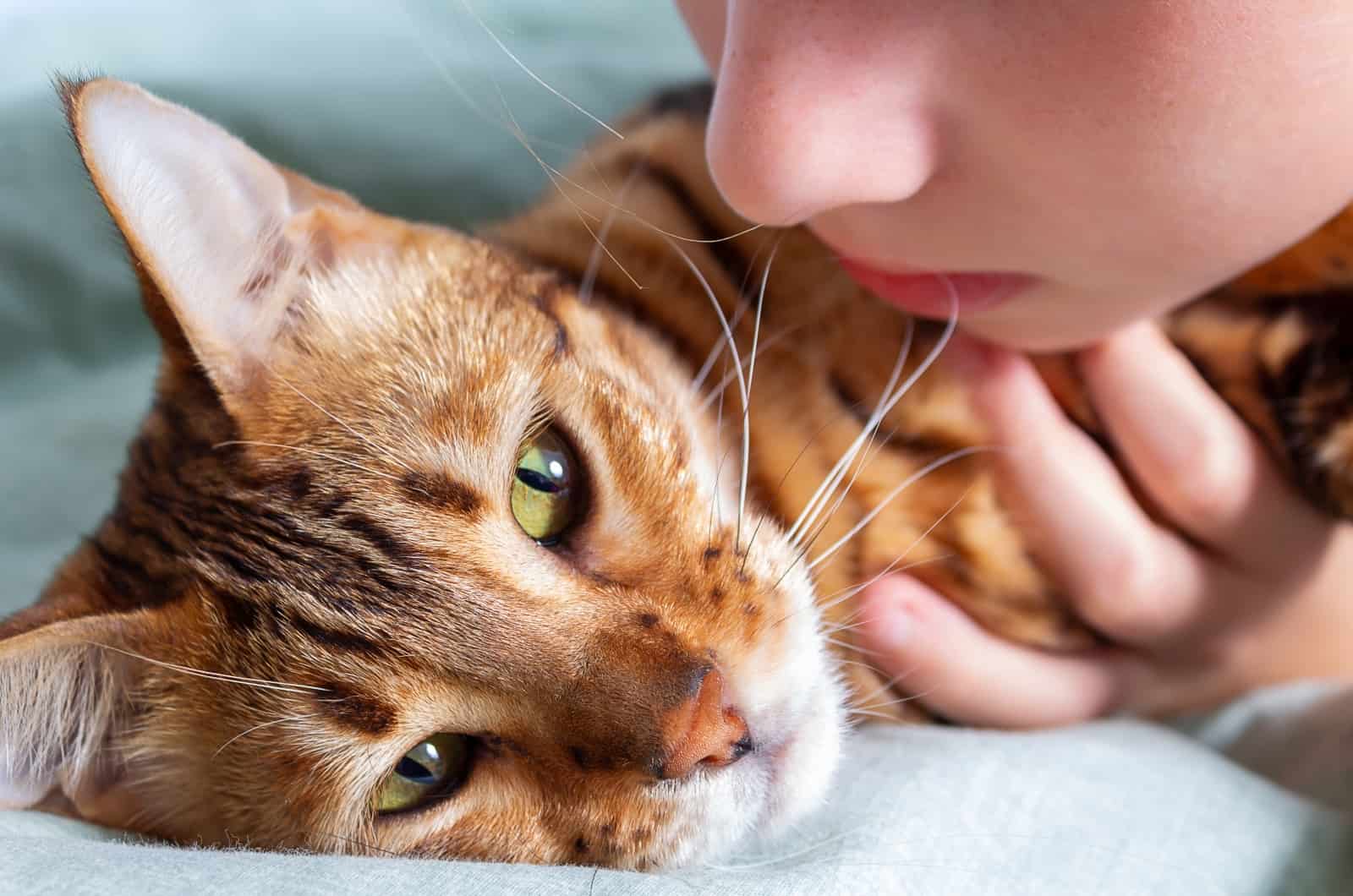
How Long Can An Old Cat Live With Hyperthyroidism?
The life expectancy of cats suffering with hyperthyroidism varies widely depending on the severity of the ailment and how well they respond to therapy.
Cats with moderate hyperthyroidism can usually live for several years if properly managed. Even with rigorous therapy, cats with severe hyperthyroidism may not live more than a few months.
Are Cats With Hyperthyroidism In Pain?
Hyperthyroidism can induce a number of symptoms, and pain is usually one of them. If a cat is in discomfort, it might be due to another health issue induced by hyperthyroidism.
What Are The Final Stages Of Hyperthyroidism In Cats?
Weight loss, vomiting, diarrhea, increased water consumption, poor coat condition, elevated heart rate, and trouble breathing are all symptoms of advanced hyperthyroidism in cats.
Complications such as heart failure, renal failure, and other organ failure can arise as well.
Should You Euthanize A Cat With Hyperthyroidism?
Hyperthyroidism is not usually a life-threatening illness, and with careful management and therapy, many cats may enjoy a comfortable and happy life. Many cats with hyperthyroidism can have a normal life for many years!
However, if the cat is suffering and there is no appropriate therapy available, euthanasia should be considered.
The decision whether to euthanize a cat or not mostly depends on the individual cat’s health. If you’d like to learn more about this issue, please, consult your vet!
In Conclusion
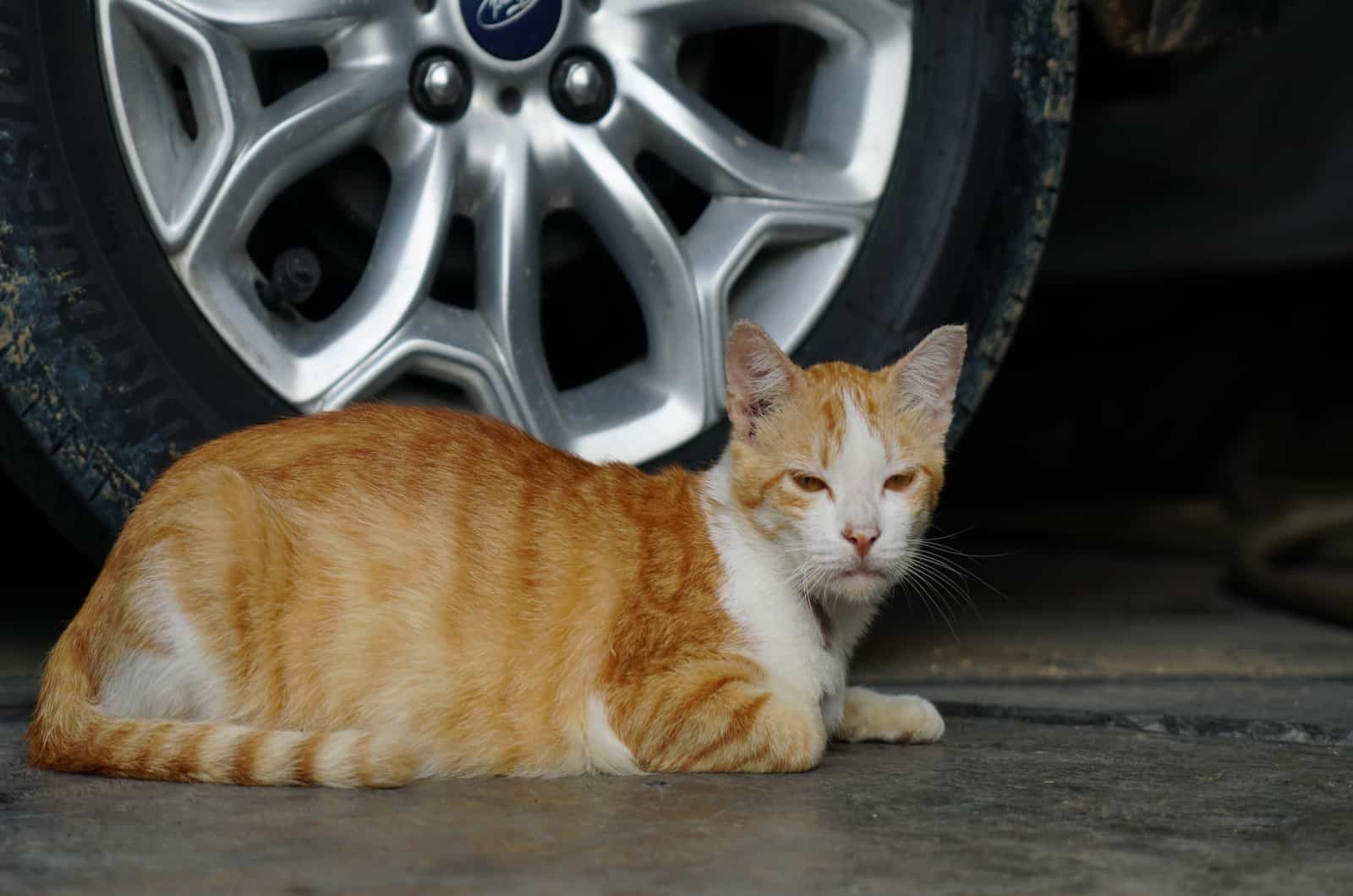
Although no one likes to think about the possibility of having to put a beloved pet to sleep, in some cases, it is the most humane thing to do, and unfortunately, that’s the reality for many owners of cats battling hyperthyroidism.
The decision to euthanize a cat should be made in consultation with a veterinarian who can provide a thorough assessment of the cat’s health, and then the owner and the vet can make the final decision together.
I sincerely hope I’ve helped you decide when to put a cat with hyperthyroidism to sleep, and that I’ve provided you with valuable information about your cat’s health issue.
No matter what decision you make, I’m sure it’ll be the right one for your kitty!
Related Articles:
When To Euthanize A Cat With IBD? Everything You Need To Know
Feline Lymphoma: When To Euthanize – Everything You Should Know

